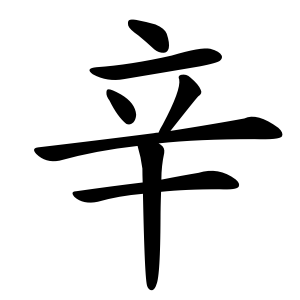辛
- spicy, hot;
- bitter hardship;
It is used to express the ideas of something being pungent, hot, or difficult and troublesome.
Etymology
This character is a pictograph representing the shape of a needle used to tattoo the forehead of slaves. Its original meaning was close to “to suffer” or “to be in pain.”
From the early Qin and Han periods onward, this character was also used to express bitter or spicy tastes found in plants and was considered one of the five basic tastes (五味).
辛 is the 8th character among the Ten Heavenly Stems (십간, 十干), which are used together with the Twelve Earthly Branches (십이지, 十二支) to form the traditional sexagenary cycle (갑자).
Additional notes
辛 is well-known in modern Korea as it appears prominently on the packaging of Nongshim's popular instant ramen brand, Shin Ramyun (신라면).
Derived characters
According to the Shuowen Jiezi (説文解字 shuōwén jiězì), the related radical 辡 (辡, meaning "eloquent" or "to argue") was originally considered a separate radical. However, 辡 is often used more for its phonetic value than for meaning.
In the Kangxi Dictionary, many characters that belonged to other radicals were reassigned under 辛, but not all. For example, 外 (outside) with the 辧 (瓣, petal radical) and 辮 (辮, braid radical) remained under their original radicals (cucurbit and silk radicals respectively), showing some inconsistency in radical classification.
Similar shape characters
There is another character, 申, used in the Earthly Branches but also read as "신" in Korean and Japanese, which can cause confusion.
Both 辛 and 申 are Korean surnames pronounced "Shin."
Characters with 辛
- 卜廿十 (YTJ)
- ⿱ 立 十
- ⿱ 亠 𢆉
